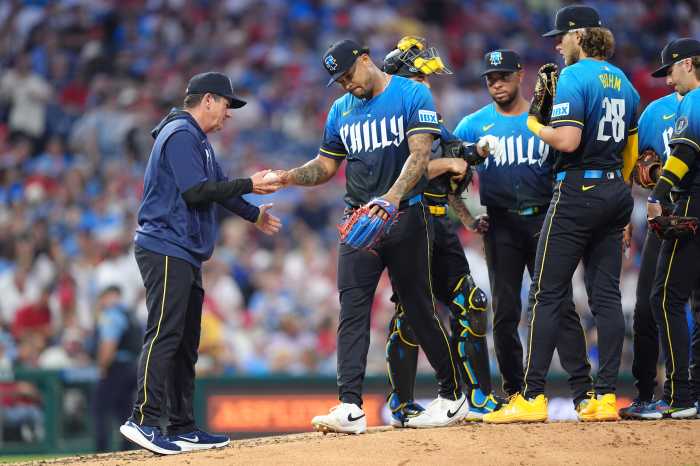West Philadelphia doctor Kermit B. Gosnell was charged yesterday with the murders of a 41-year-old woman who overdosed on anesthesia and seven infants whose spinal cords were severed with scissors after they were born healthy and viable at his illegal abortion clinic.
District Attorney’s Office detectives “stumbled upon this house of horrors” while investigating a massive, illegal drug-selling operation at Women’s Medical Society last February. Once inside the “filthy” clinic that opened in 1979, they allegedly found “bags and bottles holding aborted fetuses scattered throughout the building [and] jars containing the severed feet lining a shelf.” Some remains were kept in a refrigerator where staff kept their lunches.
While “there was testimony that this happened 100-plus times,” medical records had been destroyed. The remains of 45 fetuses were recovered, including that which the deceased patient delivered.
“Gosnell once joked about a baby that was writhing as he cut its neck ‘that’s what you call a chicken with its head cut off,’” the grand jury report states. Delaware County’s medical examiner reported an illegal abortion on a 14-year-old girl carrying a 30-week-old baby.
Investigators say Gosnell made $1.8 million in a single year and that they found $240,000 in cash hidden in his daughter’s room. Also charged are Gosnell’s wife Pearl — among nine other clinic employees “under his spell” — who allegedly helped her husband with the latest-term abortions. Untrained and unsupervised employees, including a high-school student, administered anesthesia.
DA: Clearly murder
Williams acknowledged that the case could fuel the hot-button abortion debate, but the divisive issue involves “moral questions, not legal ones.”
“A doctor who cuts into the necks, severing the spinal cords of living, breathing babies who would survive with proper medical attention, is committing murder under the law,” he said.
In its report, the grand jury acknowledges being on various sides of the issue, but “this case is not
Excerpts from the 261-page grand jury report released yesterday:
» A child of the neighborhood, Gosnell spent almost four decades running this clinic, giving back – so it appeared – to the community in which he continued to live and work. But the truth was something very different, and evident to anyone who stepped inside.
» Gosnell flagrantly violated virtually every regulation and law Pennsylvania has relating to the operation of abortion facilities. He did not comply with the basic standards of his profession. Nor did he follow state regulations pertaining to health care facilities generally.
» The clinic reeked of animal urine, courtesy of the cats that were allowed to roam (and defecate) freely. Furniture and blankets were stained with blood. Instruments were not properly sterilized. Disposable medical supplies were not disposed of; they were reused, over and over again. Medical equipment – such as the defibrillator, the EKG, the pulse oximeter, the blood pressure cuff – was generally broken; even when it worked, it wasn’t used. The emergency exit was padlocked shut.
» The people who ran this sham medical practice included no doctors other than Gosnell himself, and not even a single nurse. Two of his employees had been to medical school, but neither of them were licensed physicians. They just pretended to be.
» A national association of abortion providers declined to admit the Women’s Medical Society as a member, finding it to be the worst facility its inspector had ever seen.
» Gosnell’s contemptuous disregard for the health, safety, and dignity of his patients continued for 40 years.
» After the baby was expelled, Cross noticed that he was breathing, though not for long. After about 10 to 20 seconds, while the mother was asleep, “the doctor just slit the neck,” said Cross. Gosnell put the boy’s body in a shoebox. Cross described the baby as so big that his feet and arms hung out over the sides of the container. Cross said that she saw the baby move after his neck was cut, and after the doctor placed it in the shoebox.
Gosnell told her, “it’s the baby’s reflexes. It’s not really moving.”
The neonatologist testified that what Gosnell told his people was absolutely false. If a baby moves, it is alive. Equally troubling, it feels a “tremendous amount of pain” when its spinal cord is severed.
» The real business of the “Women’s Medical Society” was not health; it was profit. There were two primary parts to the operation. By day it was a prescription mill; by night an abortion mill.
• Pennsylvania, like other states, permits legal abortion within a regulatory framework. Physicians must, for example, provide counseling about the nature of the procedure. Minors must have parental or judicial consent. All women must wait 24 hours after first visiting the facility, in order to fully consider their decision. But Gosnell’s compliance with such requirements was casual at best.
» The real key to the business model, though, was this: Gosnell catered to the women who couldn’t get abortions elsewhere – because they were too pregnant.
» Gosnell used medication – and slaps – to silence loud or complaining patients.
» Even when Gosnell was in the building, he did not oversee the administration of anesthesia, except when the patient was white.
» Gosnell had a simple solution for the unwanted babies he delivered: he killed them. He didn’t call it that. He called it “ensuring fetal demise.” The way he ensured fetal demise was by sticking scissors into the back of the baby’s neck and cutting the spinal cord. He called that “snipping.” Over the years, there were hundreds of “snippings.” Sometimes, if Gosnell was unavailable, the “snipping” was done by one of his fake doctors, or even by one of the administrative staff. But all the employees of the Women’s Medical Society knew. Everyone there acted as if it wasn’t murder at all.
Most of these acts cannot be prosecuted, because Gosnell destroyed the files.
» Gosnell made little effort to hide his illegal abortion practice. But there were some, “the really big ones,” that even he was afraid to perform in front of others. These abortions were scheduled for Sundays, a day when the clinic was closed and none of the regular employees were present.
Only one person was allowed to assist with these special cases – Gosnell’s wife.
The files for these patients were not kept at the office; Gosnell took them home with him and disposed of them. We may never know the details of these cases. We do know, however, that, during the rest of the week, Gosnell routinely aborted and killed babies in the sixth and seventh month of pregnancy. The Sunday babies must have been bigger still.
» One woman, for example, was left lying in place for hours after Gosnell tore her cervix and colon while trying, unsuccessfully, to extract the fetus. Relatives who came to pick her up were refused entry into the building; they had to threaten to call the police. They eventually found her inside, bleeding and incoherent, and transported her to the hospital, where doctors had to remove almost half a foot of her intestines.
» On another occasion, Gosnell simply sent a patient home, after keeping her mother waiting for hours, without telling either of them that she still had fetal parts inside her. Gosnell insisted she was fine, even after signs of serious infection set in over the next several days. By the time her mother got her to the emergency room, she was unconscious and near death.
» A nineteen-year-old girl was held for several hours after Gosnell punctured her uterus. As a result of the delay, she fell into shock from blood loss, and had to undergo a hysterectomy.
» One patient went into convulsions during an abortion, fell off the procedure table, and hit her head on the floor. Gosnell wouldn’t call an ambulance, and wouldn’t let the woman’s companion leave the building so that he could call an ambulance.
» Day in and day out, the greatest risks came when the doctor wasn’t even there. Gosnell set up his practice to rely entirely on the untrained actions of his unqualified employees.
They administered drugs to induce labor, often causing rapid and painful dilation and contractions. But Gosnell did not like it when women screamed or moaned in his clinic, so the staff was under instruction to sedate them into stupor.
Of course his assistants had no idea how to manage the powerful narcotics they were using. Gosnell prepared a list of preset dosage levels to be administered in his absence. But no allowances were made for individual patient variations, or for any monitoring of vital signs. All that mattered was the money. The more you paid, the more pain relief you received. It was all completely illegal, and completely unsafe.
» The Department of State received complaints about lawsuits against Gosnell, but dismissed them as meaningless. A department attorney said there was no “pattern of conduct.” He never bothered to check a national litigation database, which would have shown that Gosnell had paid out damages to at least five different women whose internal organs he had punctured during abortions.
Apparently, the missing piece in the “pattern” was press coverage. Once that began, after the raid, the department attorney quickly managed to secure a license suspension against Gosnell.
» The doctor at CHOP who personally complained to the Pennsylvania Department of Health about the spread of venereal disease from Gosnell’s clinic, the doctor who used to refer teenage girls to Gosnell for abortions, became the head of the city’s health department two years ago.
The Hospital of the University of Pennsylvania and its subsidiary, Penn Presbyterian Medical Center, are in the same neighborhood as Gosnell’s office. State law requires hospitals to report complications from abortions. A decade ago, a Gosnell patient died at HUP after a botched abortion, and the hospital apparently filed the necessary report. But the victims kept coming in.
» On February 18, 2010, the Federal Bureau of Investigation and detectives from
the Philadelphia District Attorney’s Office executed search warrants. …
The search team waited outside until Gosnell finally arrived at the clinic, at about 8:30 p.m. When the team members entered the clinic, they were appalled, describing it to the Grand Jury as “filthy,” “deplorable,” “disgusting,” “very unsanitary, very outdated, horrendous,” and “by far, the worst” that these experienced investigators had ever encountered.
There was blood on the floor. A stench of urine filled the air. A flea-infested cat was wandering through the facility, and there were cat feces on the stairs. Semi-conscious women scheduled for abortions were moaning in the waiting room or the recovery room, where they sat on dirty recliners covered with blood-stained blankets.
Investigators found the clinic grossly unsuitable as a surgical facility. The two surgical procedure rooms were filthy and unsanitary – Agent Dougherty described them as resembling “a bad gas station restroom.”
» The doctor had his staff offer procedures the same day that patients walked in the door – as long as the patient paid in full, typically in cash.
» Very often, the patient delivered without Gosnell being present. Lewis testified that one or two babies fell out of patients each night. They dropped out on lounge chairs, on the floor, and often in the toilet. If the doctor was not there, it was not unusual for no one to tend to the mother or the baby.
» [A witness] testified about the procedure rooms: “The rooms were dirty. Blood everywhere. Dust everywhere. Nothing was clean.” The bathrooms were cleaned just once a week despite the fact that patients were vomiting in the sinks and delivering babies in the toilets.
» Medical waste and fetal remains were supposed to be picked up weekly by a licensed disposal provider. Gosnell, however, did not pay his bills in a timely manner, and the disposal provider would not pick up – sometimes for months. In the interim, and as the search team discovered during the February 18 raid, freezers at the clinic were full of discarded fetuses, and medical waste was piled up in the basement.
Sometimes … fetal remains were left out overnight. “You knew about it the next day when you opened the door … Because you could smell it as soon as you opened the door.”
» Several workers testified that Gosnell insisted on reusing plastic curettes, the tool used to remove tissue from the uteruses, even though these were made for single use only. [A witness] testified that Gosnell would make his staff reuse the curettes until they broke.
When inspectors from Pennsylvania’s Departments of Health and State surveyed the facility in February 2010, they corroborated much of what the former staff members described. Department of Health workers found that the suction source used by the doctor to perform abortions was the only one available to resuscitate patients. They found the tubing attached to the suction source was “corroded.” They also described the suction source’s vacuum meter as “covered with a brown substance making the numbers on the meter barely readable.” An oxygen mask and its tubing were “covered in a thick gray layer of a substance that appeared to be dust.”
» Drugs were administered without regard to a patient’s weight, medical condition, potential risk factors, or any other relevant factors that physicians need to weigh in determining appropriate medication. Gosnell ordered his untrained and inexperienced staff to administer drugs to patients even when they protested.
» As far back as 1989, and again in 1993, the Pennsylvania Department of Health cited him for not having any nurses in the recovery room. Gosnell ignored the warnings and the law. He just paid his fines and knowingly continued the dangerous practice of employing unqualified personnel to administer dangerous drugs. It was his modus operandi.
» [An employee] described how she and the other unlicensed staff members presented the choice of medication to the clinic’s patients: “You can pick which anesthesia you want to receive, whether you want to be up, half asleep, if you want to be knocked out, and it’s additional to your procedure, but local anesthesia is included in the smaller cases and custom anesthesia, which is the highest, to be put to sleep in the bigger cases.”
» If something went wrong during a procedure – and it inevitably did, given Gosnell’s careless techniques and gross disregard for patient safety – he avoided seeking help. Sherilyn Gillespie, the Department of State investigator who participated in the raid, interviewed a number of former patients whose experiences illustrate Gosnell’s alarming and self-serving practice of covering up life-threatening mistakes, no matter the risk to the patient.
» Another of the doctor’s practices that defies explanation was his habit of cutting the feet off of aborted fetuses and saving them in specimen jars in the clinic. Kareema Cross showed the Grand Jury photographs she had taken in 2008 of a closet where Gosnell stored jars containing severed feet. During the February 2010 raid, investigators were shocked to see a row of jars on a clinic shelf containing fetal parts. Ashley Baldwin testified that she saw about 30 such jars.
None of the medical experts who testified before the Grand Jury had ever heard of such a disturbing practice, nor could they come up with an explanation for it. The medical expert on abortions testified that cutting off the feet “is bizarre and off the wall.”
The experts uniformly rejected out of hand Gosnell’s supposed explanation that he was preserving the feet for DNA purposes should paternity ever become an issue.
»Steven Massof estimated that in 40 percent of the second-trimester abortions performed by Gosnell, the fetuses were beyond 24 weeks gestational age. Latosha Lewis testified that Gosnell performed procedures over 24 weeks “too much to count, ” and ones up to 26 weeks “very often.”
In the last few years, she testified, Gosnell increasingly saw out-of-state referrals, which were all second-trimester, or beyond. By these estimates, Gosnell performed at least four or five illegal abortions every week.
When a detective asked the doctor what percentage of the fetuses – including the first- and second-trimester fetuses – found at the facility during the February 2010 raid were beyond 24 weeks, Gosnell himself estimated “ten or twenty percent at the most.”































